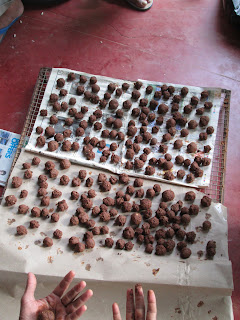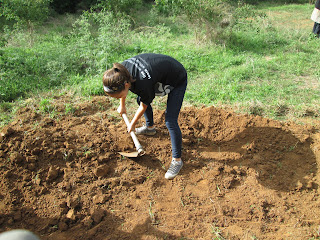Taking this permaculture course with Rico was truly an eye-opening experience. Not only did he show us the ins and outs of permaculture, but we also discussed the importance of subsistence farming and self-sustained living in order to create a better planet. The definition he gave us of permaculture is "A design system to create a regenerative human habitat." It's basically an organic farming and reforestation technique that mimics natural processes to help heal the Earth.
The week-long course was very intensive, we were almost always either in the classroom learning different concepts, or out in the field doing hands-on projects.
This is me with a huge bale of hay that was used to make a compost pile.

This is the compost pile before completion with a nice, fresh layer of cow manure on top! Some other layers included sticks and twigs, hay, brown mulch, green plants and banana leaves, and rice husks. Micro-organism galore.
To regenerate a forest after the soil is damaged, one tactic is to first plant all sorts of legume species that omit nitrogen and other minerals into the soil, that can also be cut to be used as green manure for future trees. This increases the quality of the soil and the likelihood that plants beneficial to humans can grow effectively later on.
One way to plant a high amount of these nitrogen-fixing plants is to roll a bunch of them into 'seed balls' of mud and composted soil, then bury them around the property. Here are our beautiful balls!
In order to control the water runoff from rainfall and raise the water table, 'swales' are made on the land's contour lines. A swale is basically a long pit that is dug, and all the soil brought up is put into a mound alongside the pit. We used 'mumate's (mummah-tees) for the digging instead of shovels, which means we had to bend down and pull all the soil towards us to dig. 3-4 hours of this and I'm still sore four days later.
There were a lot of people like me who aren't used to hard manual labor, but at least I tried! Some of them left after the first half hour or so because they didn't want to work.
There were many other projects we worked on, but these are the main ones!




No comments:
Post a Comment